G107460: Organisational Identity and Culture in Business Psychology
VerifiedAdded on 2023/06/08
|11
|3282
|369
Essay
AI Summary
This essay provides a psychological analysis of organizational culture and identity, exploring how these concepts are defined and differentiated. It discusses organizational identity as the core values and distinguishing characteristics of an organization, influencing its strategies and management style. The essay also examines organizational culture as the cumulative beliefs, values, and assumptions within an organization, impacting individual and organizational performance. Key models such as Hatch and Schultz’s Organizational Identity Dynamics Model and the Three Bell Curves framework are analyzed, highlighting the importance of culture, image, and employee engagement in shaping organizational identity and overall success. The essay also touches upon Handy's Model and emphasizes the role of employees, customers, and the nature of work in fostering a positive organizational culture. Desklib offers a wealth of resources, including solved assignments and past papers, for students seeking to deepen their understanding of these crucial concepts.
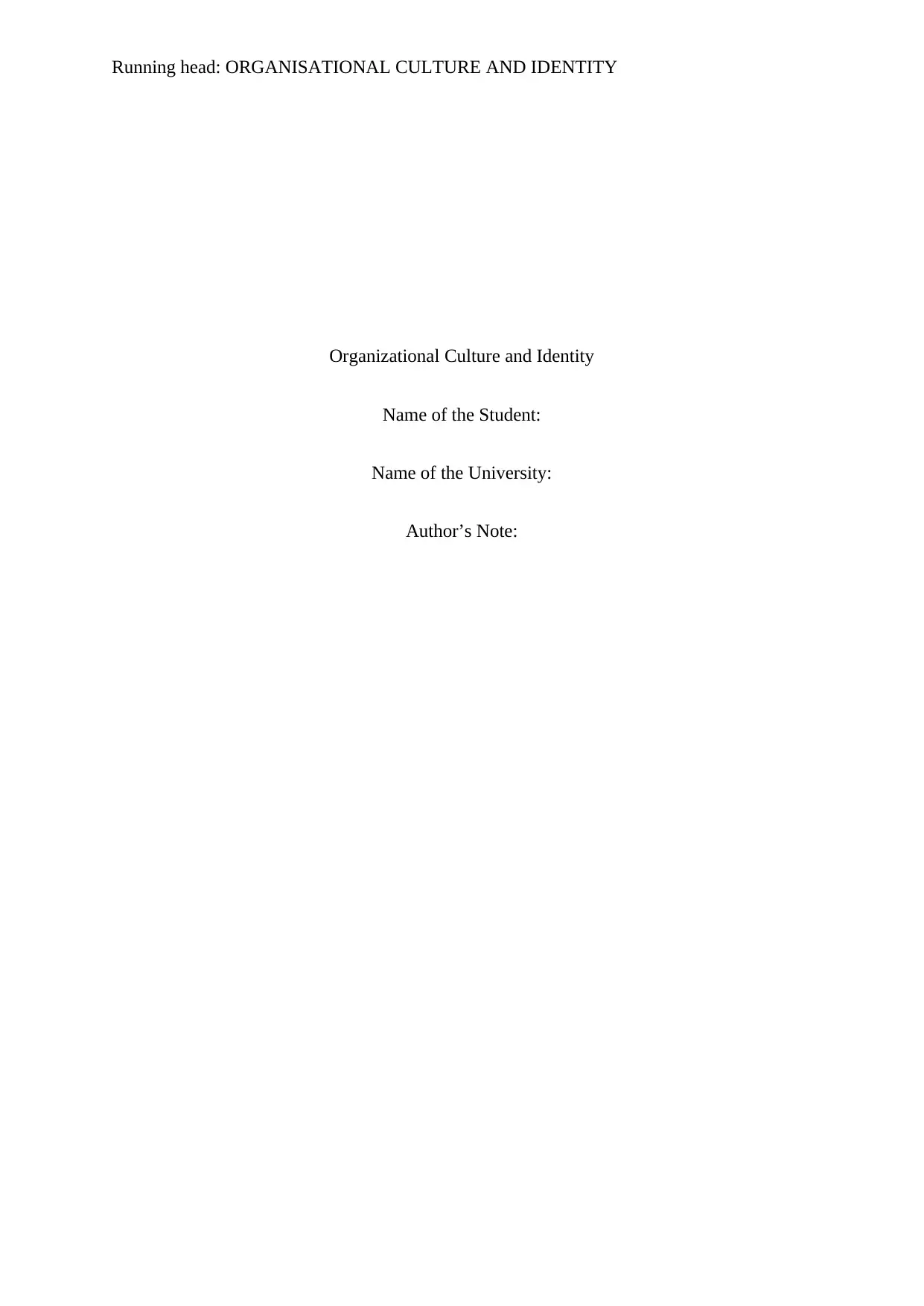
Running head: ORGANISATIONAL CULTURE AND IDENTITY
Organizational Culture and Identity
Name of the Student:
Name of the University:
Author’s Note:
Organizational Culture and Identity
Name of the Student:
Name of the University:
Author’s Note:
Paraphrase This Document
Need a fresh take? Get an instant paraphrase of this document with our AI Paraphraser
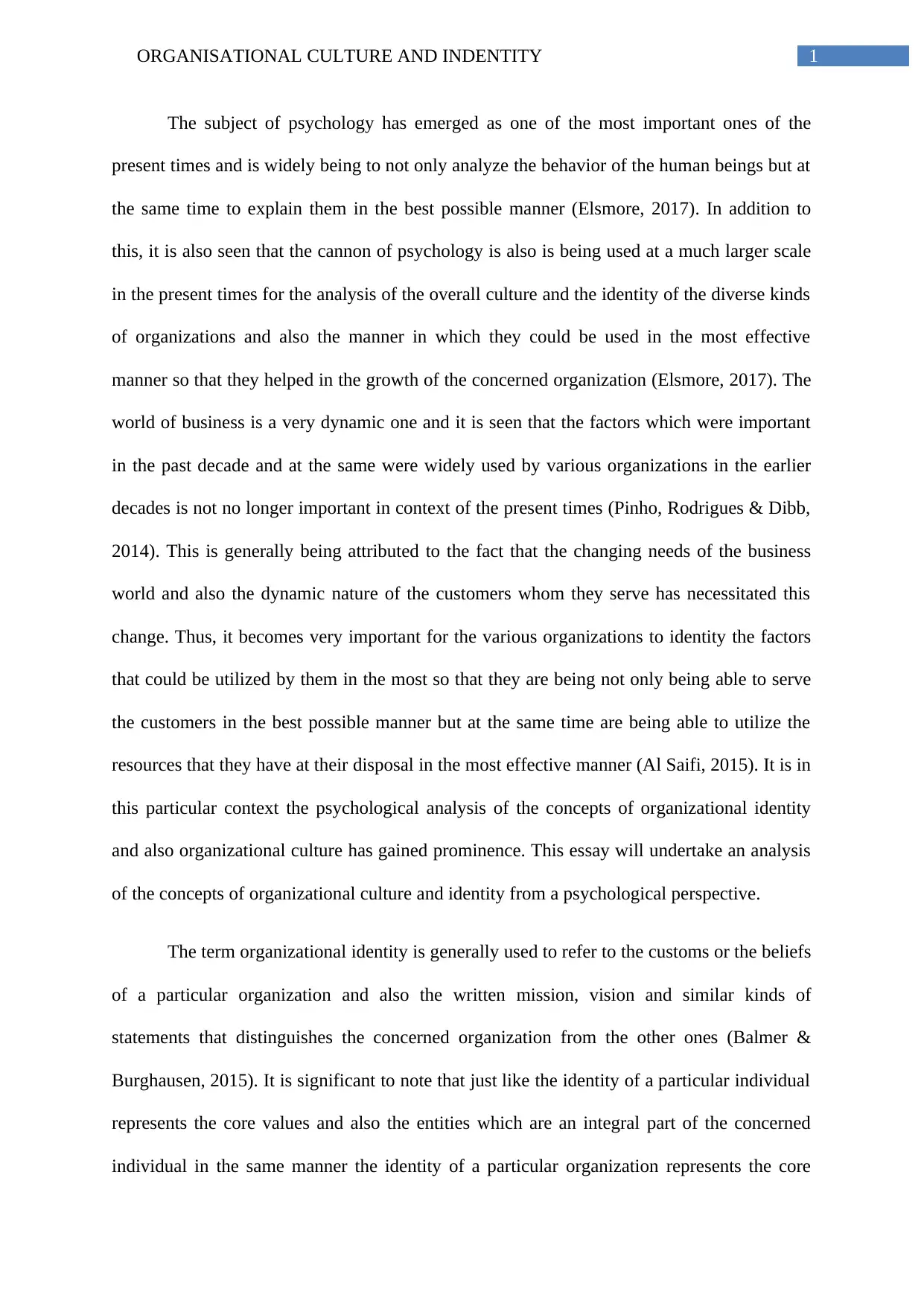
1ORGANISATIONAL CULTURE AND INDENTITY
The subject of psychology has emerged as one of the most important ones of the
present times and is widely being to not only analyze the behavior of the human beings but at
the same time to explain them in the best possible manner (Elsmore, 2017). In addition to
this, it is also seen that the cannon of psychology is also is being used at a much larger scale
in the present times for the analysis of the overall culture and the identity of the diverse kinds
of organizations and also the manner in which they could be used in the most effective
manner so that they helped in the growth of the concerned organization (Elsmore, 2017). The
world of business is a very dynamic one and it is seen that the factors which were important
in the past decade and at the same were widely used by various organizations in the earlier
decades is not no longer important in context of the present times (Pinho, Rodrigues & Dibb,
2014). This is generally being attributed to the fact that the changing needs of the business
world and also the dynamic nature of the customers whom they serve has necessitated this
change. Thus, it becomes very important for the various organizations to identity the factors
that could be utilized by them in the most so that they are being not only being able to serve
the customers in the best possible manner but at the same time are being able to utilize the
resources that they have at their disposal in the most effective manner (Al Saifi, 2015). It is in
this particular context the psychological analysis of the concepts of organizational identity
and also organizational culture has gained prominence. This essay will undertake an analysis
of the concepts of organizational culture and identity from a psychological perspective.
The term organizational identity is generally used to refer to the customs or the beliefs
of a particular organization and also the written mission, vision and similar kinds of
statements that distinguishes the concerned organization from the other ones (Balmer &
Burghausen, 2015). It is significant to note that just like the identity of a particular individual
represents the core values and also the entities which are an integral part of the concerned
individual in the same manner the identity of a particular organization represents the core
The subject of psychology has emerged as one of the most important ones of the
present times and is widely being to not only analyze the behavior of the human beings but at
the same time to explain them in the best possible manner (Elsmore, 2017). In addition to
this, it is also seen that the cannon of psychology is also is being used at a much larger scale
in the present times for the analysis of the overall culture and the identity of the diverse kinds
of organizations and also the manner in which they could be used in the most effective
manner so that they helped in the growth of the concerned organization (Elsmore, 2017). The
world of business is a very dynamic one and it is seen that the factors which were important
in the past decade and at the same were widely used by various organizations in the earlier
decades is not no longer important in context of the present times (Pinho, Rodrigues & Dibb,
2014). This is generally being attributed to the fact that the changing needs of the business
world and also the dynamic nature of the customers whom they serve has necessitated this
change. Thus, it becomes very important for the various organizations to identity the factors
that could be utilized by them in the most so that they are being not only being able to serve
the customers in the best possible manner but at the same time are being able to utilize the
resources that they have at their disposal in the most effective manner (Al Saifi, 2015). It is in
this particular context the psychological analysis of the concepts of organizational identity
and also organizational culture has gained prominence. This essay will undertake an analysis
of the concepts of organizational culture and identity from a psychological perspective.
The term organizational identity is generally used to refer to the customs or the beliefs
of a particular organization and also the written mission, vision and similar kinds of
statements that distinguishes the concerned organization from the other ones (Balmer &
Burghausen, 2015). It is significant to note that just like the identity of a particular individual
represents the core values and also the entities which are an integral part of the concerned
individual in the same manner the identity of a particular organization represents the core
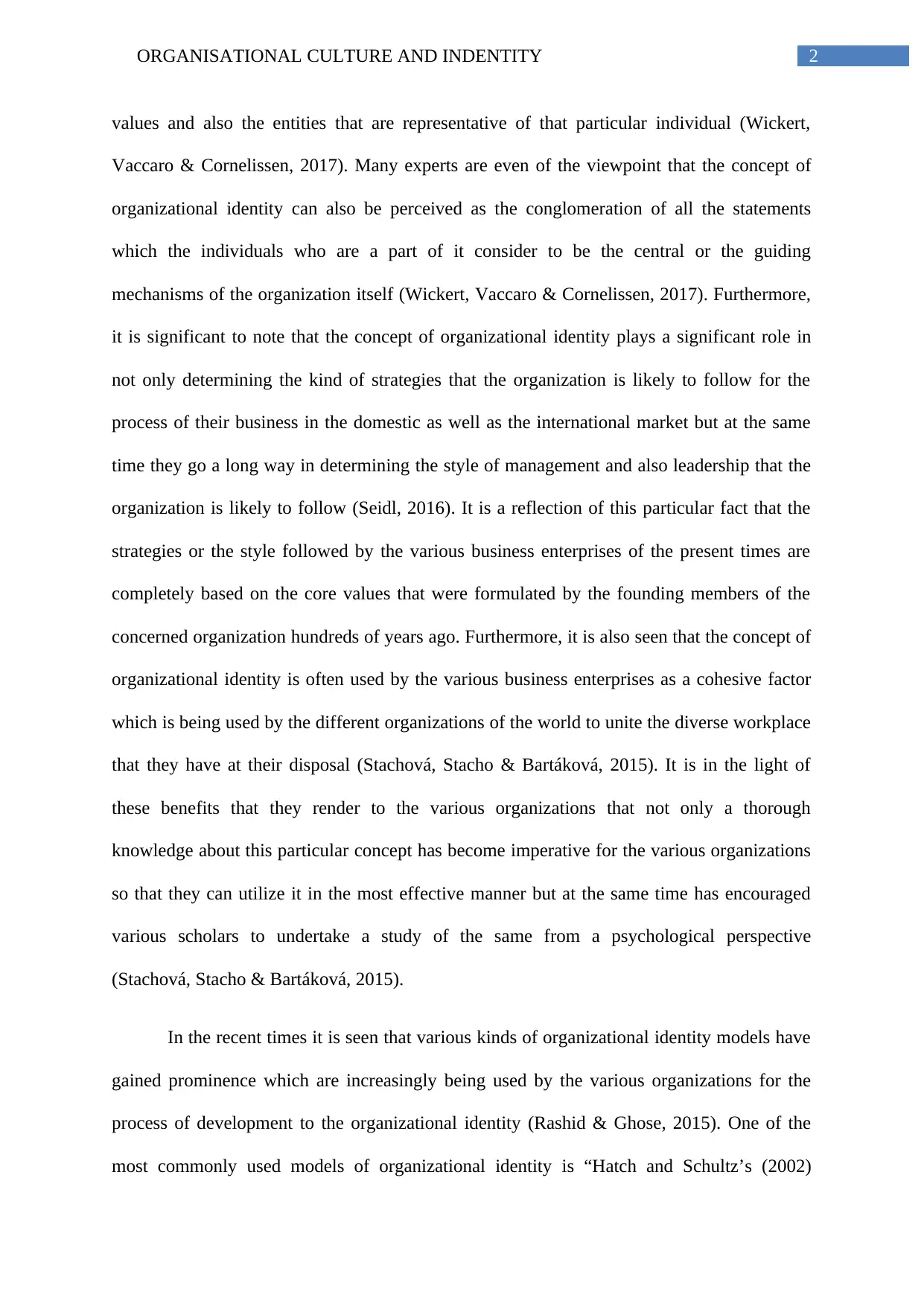
2ORGANISATIONAL CULTURE AND INDENTITY
values and also the entities that are representative of that particular individual (Wickert,
Vaccaro & Cornelissen, 2017). Many experts are even of the viewpoint that the concept of
organizational identity can also be perceived as the conglomeration of all the statements
which the individuals who are a part of it consider to be the central or the guiding
mechanisms of the organization itself (Wickert, Vaccaro & Cornelissen, 2017). Furthermore,
it is significant to note that the concept of organizational identity plays a significant role in
not only determining the kind of strategies that the organization is likely to follow for the
process of their business in the domestic as well as the international market but at the same
time they go a long way in determining the style of management and also leadership that the
organization is likely to follow (Seidl, 2016). It is a reflection of this particular fact that the
strategies or the style followed by the various business enterprises of the present times are
completely based on the core values that were formulated by the founding members of the
concerned organization hundreds of years ago. Furthermore, it is also seen that the concept of
organizational identity is often used by the various business enterprises as a cohesive factor
which is being used by the different organizations of the world to unite the diverse workplace
that they have at their disposal (Stachová, Stacho & Bartáková, 2015). It is in the light of
these benefits that they render to the various organizations that not only a thorough
knowledge about this particular concept has become imperative for the various organizations
so that they can utilize it in the most effective manner but at the same time has encouraged
various scholars to undertake a study of the same from a psychological perspective
(Stachová, Stacho & Bartáková, 2015).
In the recent times it is seen that various kinds of organizational identity models have
gained prominence which are increasingly being used by the various organizations for the
process of development to the organizational identity (Rashid & Ghose, 2015). One of the
most commonly used models of organizational identity is “Hatch and Schultz’s (2002)
values and also the entities that are representative of that particular individual (Wickert,
Vaccaro & Cornelissen, 2017). Many experts are even of the viewpoint that the concept of
organizational identity can also be perceived as the conglomeration of all the statements
which the individuals who are a part of it consider to be the central or the guiding
mechanisms of the organization itself (Wickert, Vaccaro & Cornelissen, 2017). Furthermore,
it is significant to note that the concept of organizational identity plays a significant role in
not only determining the kind of strategies that the organization is likely to follow for the
process of their business in the domestic as well as the international market but at the same
time they go a long way in determining the style of management and also leadership that the
organization is likely to follow (Seidl, 2016). It is a reflection of this particular fact that the
strategies or the style followed by the various business enterprises of the present times are
completely based on the core values that were formulated by the founding members of the
concerned organization hundreds of years ago. Furthermore, it is also seen that the concept of
organizational identity is often used by the various business enterprises as a cohesive factor
which is being used by the different organizations of the world to unite the diverse workplace
that they have at their disposal (Stachová, Stacho & Bartáková, 2015). It is in the light of
these benefits that they render to the various organizations that not only a thorough
knowledge about this particular concept has become imperative for the various organizations
so that they can utilize it in the most effective manner but at the same time has encouraged
various scholars to undertake a study of the same from a psychological perspective
(Stachová, Stacho & Bartáková, 2015).
In the recent times it is seen that various kinds of organizational identity models have
gained prominence which are increasingly being used by the various organizations for the
process of development to the organizational identity (Rashid & Ghose, 2015). One of the
most commonly used models of organizational identity is “Hatch and Schultz’s (2002)
⊘ This is a preview!⊘
Do you want full access?
Subscribe today to unlock all pages.

Trusted by 1+ million students worldwide
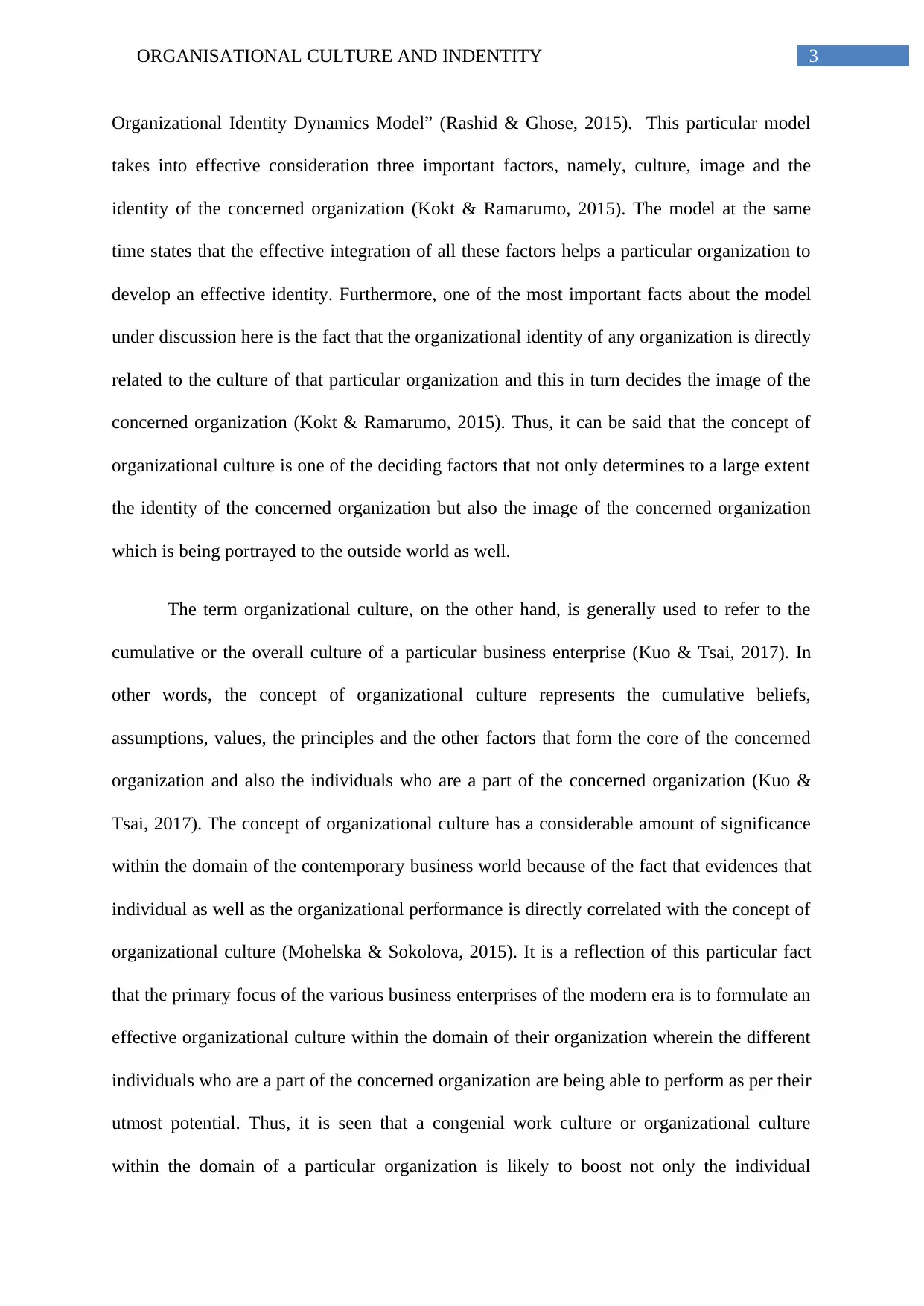
3ORGANISATIONAL CULTURE AND INDENTITY
Organizational Identity Dynamics Model” (Rashid & Ghose, 2015). This particular model
takes into effective consideration three important factors, namely, culture, image and the
identity of the concerned organization (Kokt & Ramarumo, 2015). The model at the same
time states that the effective integration of all these factors helps a particular organization to
develop an effective identity. Furthermore, one of the most important facts about the model
under discussion here is the fact that the organizational identity of any organization is directly
related to the culture of that particular organization and this in turn decides the image of the
concerned organization (Kokt & Ramarumo, 2015). Thus, it can be said that the concept of
organizational culture is one of the deciding factors that not only determines to a large extent
the identity of the concerned organization but also the image of the concerned organization
which is being portrayed to the outside world as well.
The term organizational culture, on the other hand, is generally used to refer to the
cumulative or the overall culture of a particular business enterprise (Kuo & Tsai, 2017). In
other words, the concept of organizational culture represents the cumulative beliefs,
assumptions, values, the principles and the other factors that form the core of the concerned
organization and also the individuals who are a part of the concerned organization (Kuo &
Tsai, 2017). The concept of organizational culture has a considerable amount of significance
within the domain of the contemporary business world because of the fact that evidences that
individual as well as the organizational performance is directly correlated with the concept of
organizational culture (Mohelska & Sokolova, 2015). It is a reflection of this particular fact
that the primary focus of the various business enterprises of the modern era is to formulate an
effective organizational culture within the domain of their organization wherein the different
individuals who are a part of the concerned organization are being able to perform as per their
utmost potential. Thus, it is seen that a congenial work culture or organizational culture
within the domain of a particular organization is likely to boost not only the individual
Organizational Identity Dynamics Model” (Rashid & Ghose, 2015). This particular model
takes into effective consideration three important factors, namely, culture, image and the
identity of the concerned organization (Kokt & Ramarumo, 2015). The model at the same
time states that the effective integration of all these factors helps a particular organization to
develop an effective identity. Furthermore, one of the most important facts about the model
under discussion here is the fact that the organizational identity of any organization is directly
related to the culture of that particular organization and this in turn decides the image of the
concerned organization (Kokt & Ramarumo, 2015). Thus, it can be said that the concept of
organizational culture is one of the deciding factors that not only determines to a large extent
the identity of the concerned organization but also the image of the concerned organization
which is being portrayed to the outside world as well.
The term organizational culture, on the other hand, is generally used to refer to the
cumulative or the overall culture of a particular business enterprise (Kuo & Tsai, 2017). In
other words, the concept of organizational culture represents the cumulative beliefs,
assumptions, values, the principles and the other factors that form the core of the concerned
organization and also the individuals who are a part of the concerned organization (Kuo &
Tsai, 2017). The concept of organizational culture has a considerable amount of significance
within the domain of the contemporary business world because of the fact that evidences that
individual as well as the organizational performance is directly correlated with the concept of
organizational culture (Mohelska & Sokolova, 2015). It is a reflection of this particular fact
that the primary focus of the various business enterprises of the modern era is to formulate an
effective organizational culture within the domain of their organization wherein the different
individuals who are a part of the concerned organization are being able to perform as per their
utmost potential. Thus, it is seen that a congenial work culture or organizational culture
within the domain of a particular organization is likely to boost not only the individual
Paraphrase This Document
Need a fresh take? Get an instant paraphrase of this document with our AI Paraphraser
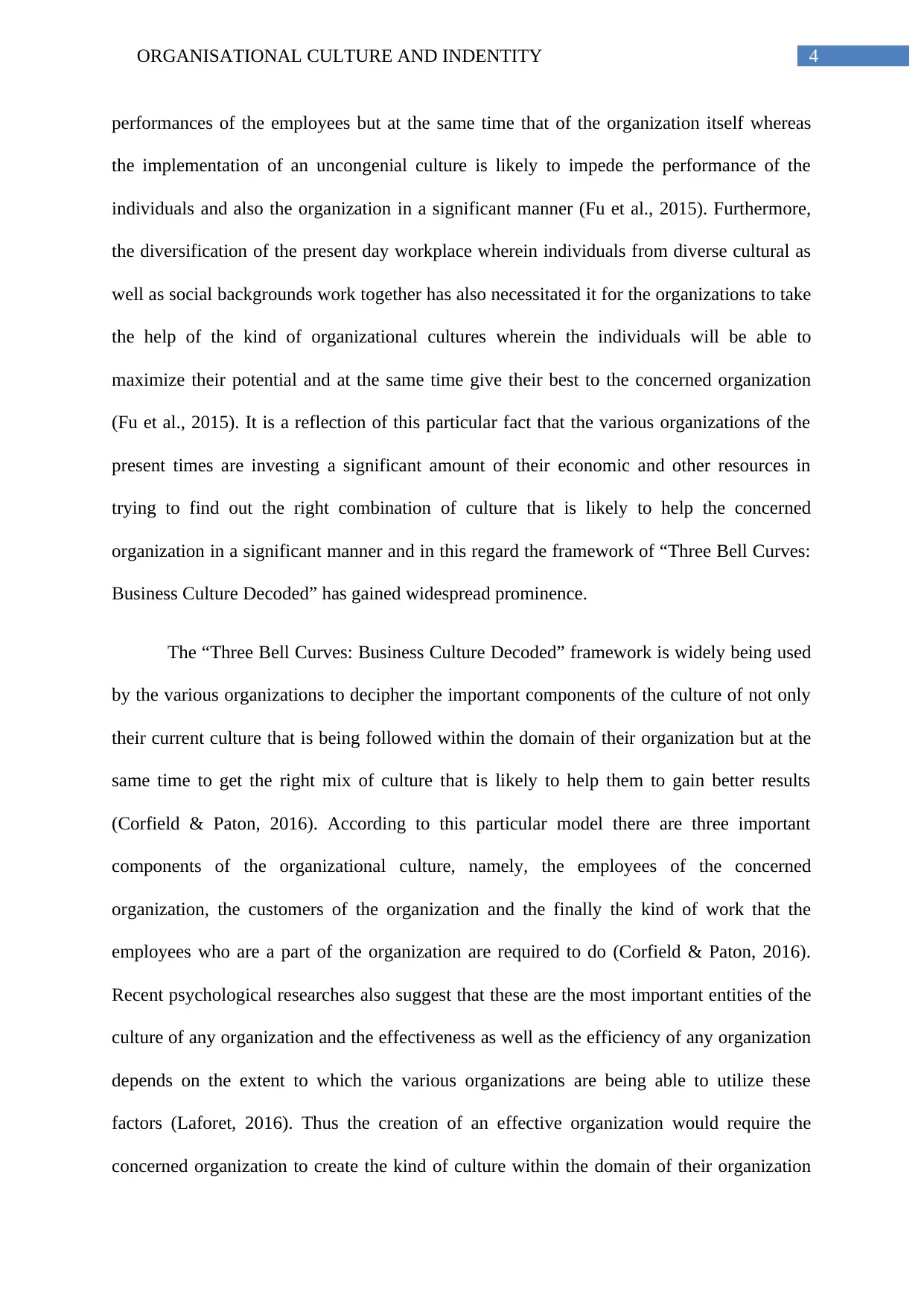
4ORGANISATIONAL CULTURE AND INDENTITY
performances of the employees but at the same time that of the organization itself whereas
the implementation of an uncongenial culture is likely to impede the performance of the
individuals and also the organization in a significant manner (Fu et al., 2015). Furthermore,
the diversification of the present day workplace wherein individuals from diverse cultural as
well as social backgrounds work together has also necessitated it for the organizations to take
the help of the kind of organizational cultures wherein the individuals will be able to
maximize their potential and at the same time give their best to the concerned organization
(Fu et al., 2015). It is a reflection of this particular fact that the various organizations of the
present times are investing a significant amount of their economic and other resources in
trying to find out the right combination of culture that is likely to help the concerned
organization in a significant manner and in this regard the framework of “Three Bell Curves:
Business Culture Decoded” has gained widespread prominence.
The “Three Bell Curves: Business Culture Decoded” framework is widely being used
by the various organizations to decipher the important components of the culture of not only
their current culture that is being followed within the domain of their organization but at the
same time to get the right mix of culture that is likely to help them to gain better results
(Corfield & Paton, 2016). According to this particular model there are three important
components of the organizational culture, namely, the employees of the concerned
organization, the customers of the organization and the finally the kind of work that the
employees who are a part of the organization are required to do (Corfield & Paton, 2016).
Recent psychological researches also suggest that these are the most important entities of the
culture of any organization and the effectiveness as well as the efficiency of any organization
depends on the extent to which the various organizations are being able to utilize these
factors (Laforet, 2016). Thus the creation of an effective organization would require the
concerned organization to create the kind of culture within the domain of their organization
performances of the employees but at the same time that of the organization itself whereas
the implementation of an uncongenial culture is likely to impede the performance of the
individuals and also the organization in a significant manner (Fu et al., 2015). Furthermore,
the diversification of the present day workplace wherein individuals from diverse cultural as
well as social backgrounds work together has also necessitated it for the organizations to take
the help of the kind of organizational cultures wherein the individuals will be able to
maximize their potential and at the same time give their best to the concerned organization
(Fu et al., 2015). It is a reflection of this particular fact that the various organizations of the
present times are investing a significant amount of their economic and other resources in
trying to find out the right combination of culture that is likely to help the concerned
organization in a significant manner and in this regard the framework of “Three Bell Curves:
Business Culture Decoded” has gained widespread prominence.
The “Three Bell Curves: Business Culture Decoded” framework is widely being used
by the various organizations to decipher the important components of the culture of not only
their current culture that is being followed within the domain of their organization but at the
same time to get the right mix of culture that is likely to help them to gain better results
(Corfield & Paton, 2016). According to this particular model there are three important
components of the organizational culture, namely, the employees of the concerned
organization, the customers of the organization and the finally the kind of work that the
employees who are a part of the organization are required to do (Corfield & Paton, 2016).
Recent psychological researches also suggest that these are the most important entities of the
culture of any organization and the effectiveness as well as the efficiency of any organization
depends on the extent to which the various organizations are being able to utilize these
factors (Laforet, 2016). Thus the creation of an effective organization would require the
concerned organization to create the kind of culture within the domain of their organization
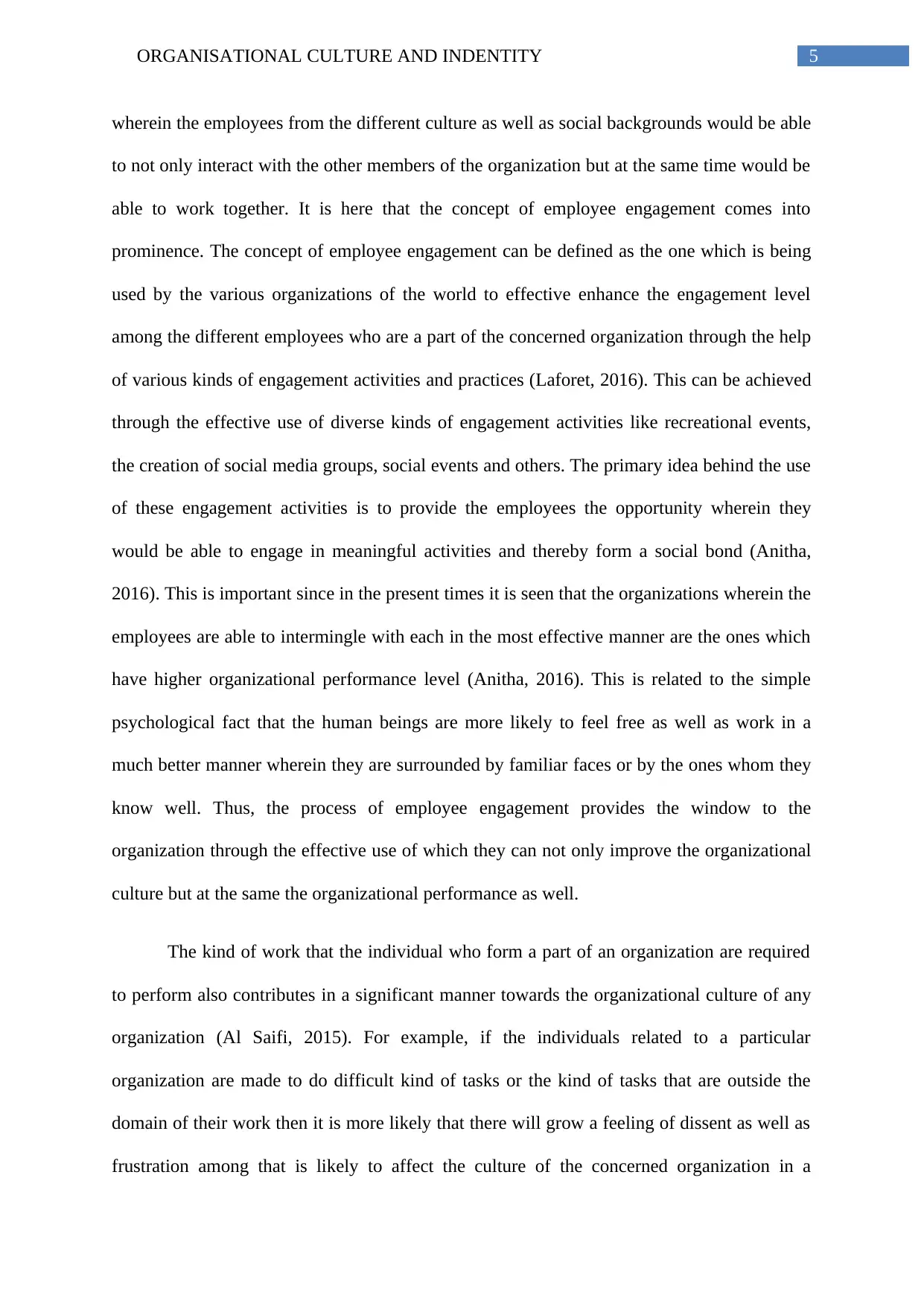
5ORGANISATIONAL CULTURE AND INDENTITY
wherein the employees from the different culture as well as social backgrounds would be able
to not only interact with the other members of the organization but at the same time would be
able to work together. It is here that the concept of employee engagement comes into
prominence. The concept of employee engagement can be defined as the one which is being
used by the various organizations of the world to effective enhance the engagement level
among the different employees who are a part of the concerned organization through the help
of various kinds of engagement activities and practices (Laforet, 2016). This can be achieved
through the effective use of diverse kinds of engagement activities like recreational events,
the creation of social media groups, social events and others. The primary idea behind the use
of these engagement activities is to provide the employees the opportunity wherein they
would be able to engage in meaningful activities and thereby form a social bond (Anitha,
2016). This is important since in the present times it is seen that the organizations wherein the
employees are able to intermingle with each in the most effective manner are the ones which
have higher organizational performance level (Anitha, 2016). This is related to the simple
psychological fact that the human beings are more likely to feel free as well as work in a
much better manner wherein they are surrounded by familiar faces or by the ones whom they
know well. Thus, the process of employee engagement provides the window to the
organization through the effective use of which they can not only improve the organizational
culture but at the same the organizational performance as well.
The kind of work that the individual who form a part of an organization are required
to perform also contributes in a significant manner towards the organizational culture of any
organization (Al Saifi, 2015). For example, if the individuals related to a particular
organization are made to do difficult kind of tasks or the kind of tasks that are outside the
domain of their work then it is more likely that there will grow a feeling of dissent as well as
frustration among that is likely to affect the culture of the concerned organization in a
wherein the employees from the different culture as well as social backgrounds would be able
to not only interact with the other members of the organization but at the same time would be
able to work together. It is here that the concept of employee engagement comes into
prominence. The concept of employee engagement can be defined as the one which is being
used by the various organizations of the world to effective enhance the engagement level
among the different employees who are a part of the concerned organization through the help
of various kinds of engagement activities and practices (Laforet, 2016). This can be achieved
through the effective use of diverse kinds of engagement activities like recreational events,
the creation of social media groups, social events and others. The primary idea behind the use
of these engagement activities is to provide the employees the opportunity wherein they
would be able to engage in meaningful activities and thereby form a social bond (Anitha,
2016). This is important since in the present times it is seen that the organizations wherein the
employees are able to intermingle with each in the most effective manner are the ones which
have higher organizational performance level (Anitha, 2016). This is related to the simple
psychological fact that the human beings are more likely to feel free as well as work in a
much better manner wherein they are surrounded by familiar faces or by the ones whom they
know well. Thus, the process of employee engagement provides the window to the
organization through the effective use of which they can not only improve the organizational
culture but at the same the organizational performance as well.
The kind of work that the individual who form a part of an organization are required
to perform also contributes in a significant manner towards the organizational culture of any
organization (Al Saifi, 2015). For example, if the individuals related to a particular
organization are made to do difficult kind of tasks or the kind of tasks that are outside the
domain of their work then it is more likely that there will grow a feeling of dissent as well as
frustration among that is likely to affect the culture of the concerned organization in a
⊘ This is a preview!⊘
Do you want full access?
Subscribe today to unlock all pages.

Trusted by 1+ million students worldwide
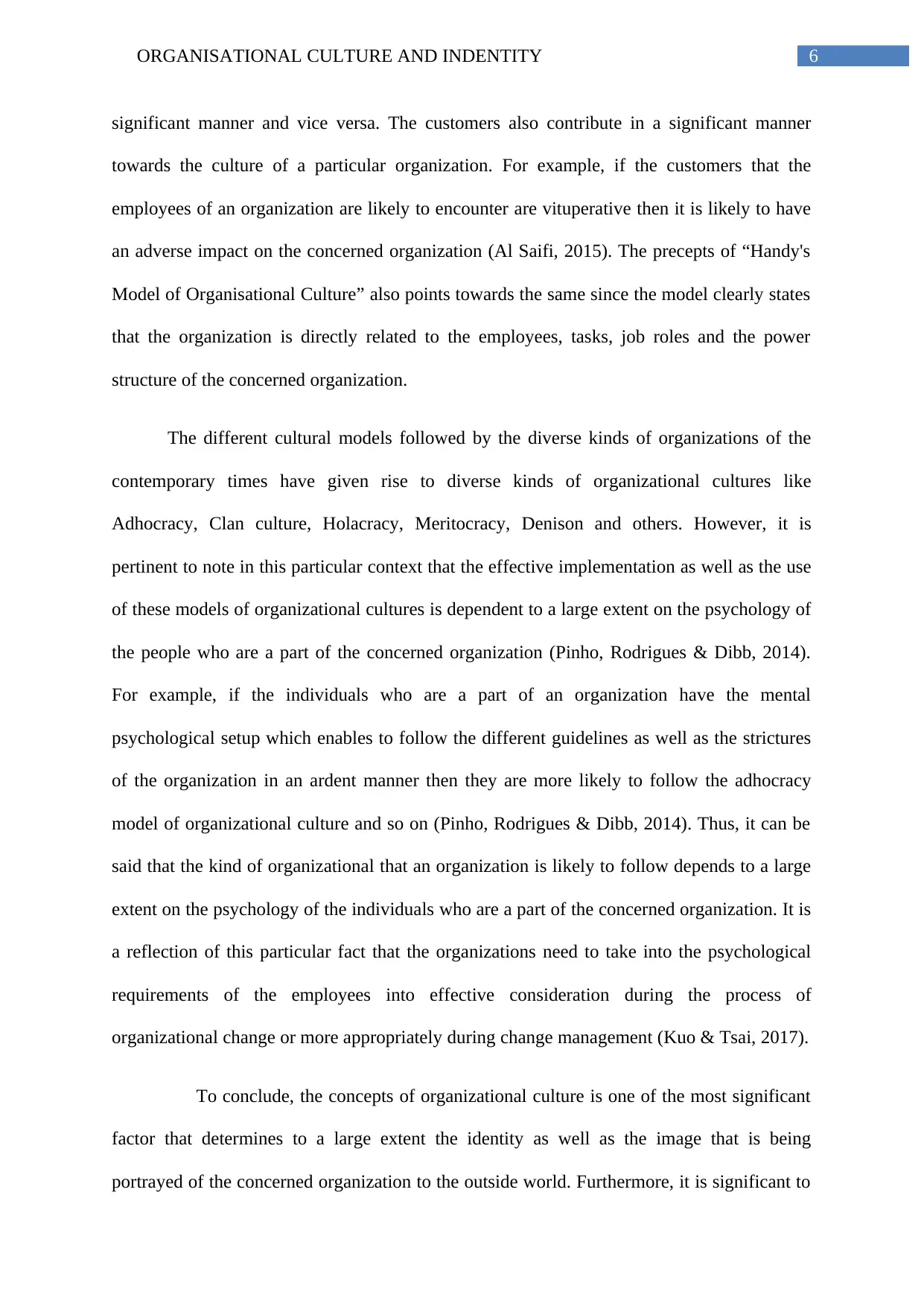
6ORGANISATIONAL CULTURE AND INDENTITY
significant manner and vice versa. The customers also contribute in a significant manner
towards the culture of a particular organization. For example, if the customers that the
employees of an organization are likely to encounter are vituperative then it is likely to have
an adverse impact on the concerned organization (Al Saifi, 2015). The precepts of “Handy's
Model of Organisational Culture” also points towards the same since the model clearly states
that the organization is directly related to the employees, tasks, job roles and the power
structure of the concerned organization.
The different cultural models followed by the diverse kinds of organizations of the
contemporary times have given rise to diverse kinds of organizational cultures like
Adhocracy, Clan culture, Holacracy, Meritocracy, Denison and others. However, it is
pertinent to note in this particular context that the effective implementation as well as the use
of these models of organizational cultures is dependent to a large extent on the psychology of
the people who are a part of the concerned organization (Pinho, Rodrigues & Dibb, 2014).
For example, if the individuals who are a part of an organization have the mental
psychological setup which enables to follow the different guidelines as well as the strictures
of the organization in an ardent manner then they are more likely to follow the adhocracy
model of organizational culture and so on (Pinho, Rodrigues & Dibb, 2014). Thus, it can be
said that the kind of organizational that an organization is likely to follow depends to a large
extent on the psychology of the individuals who are a part of the concerned organization. It is
a reflection of this particular fact that the organizations need to take into the psychological
requirements of the employees into effective consideration during the process of
organizational change or more appropriately during change management (Kuo & Tsai, 2017).
To conclude, the concepts of organizational culture is one of the most significant
factor that determines to a large extent the identity as well as the image that is being
portrayed of the concerned organization to the outside world. Furthermore, it is significant to
significant manner and vice versa. The customers also contribute in a significant manner
towards the culture of a particular organization. For example, if the customers that the
employees of an organization are likely to encounter are vituperative then it is likely to have
an adverse impact on the concerned organization (Al Saifi, 2015). The precepts of “Handy's
Model of Organisational Culture” also points towards the same since the model clearly states
that the organization is directly related to the employees, tasks, job roles and the power
structure of the concerned organization.
The different cultural models followed by the diverse kinds of organizations of the
contemporary times have given rise to diverse kinds of organizational cultures like
Adhocracy, Clan culture, Holacracy, Meritocracy, Denison and others. However, it is
pertinent to note in this particular context that the effective implementation as well as the use
of these models of organizational cultures is dependent to a large extent on the psychology of
the people who are a part of the concerned organization (Pinho, Rodrigues & Dibb, 2014).
For example, if the individuals who are a part of an organization have the mental
psychological setup which enables to follow the different guidelines as well as the strictures
of the organization in an ardent manner then they are more likely to follow the adhocracy
model of organizational culture and so on (Pinho, Rodrigues & Dibb, 2014). Thus, it can be
said that the kind of organizational that an organization is likely to follow depends to a large
extent on the psychology of the individuals who are a part of the concerned organization. It is
a reflection of this particular fact that the organizations need to take into the psychological
requirements of the employees into effective consideration during the process of
organizational change or more appropriately during change management (Kuo & Tsai, 2017).
To conclude, the concepts of organizational culture is one of the most significant
factor that determines to a large extent the identity as well as the image that is being
portrayed of the concerned organization to the outside world. Furthermore, it is significant to
Paraphrase This Document
Need a fresh take? Get an instant paraphrase of this document with our AI Paraphraser
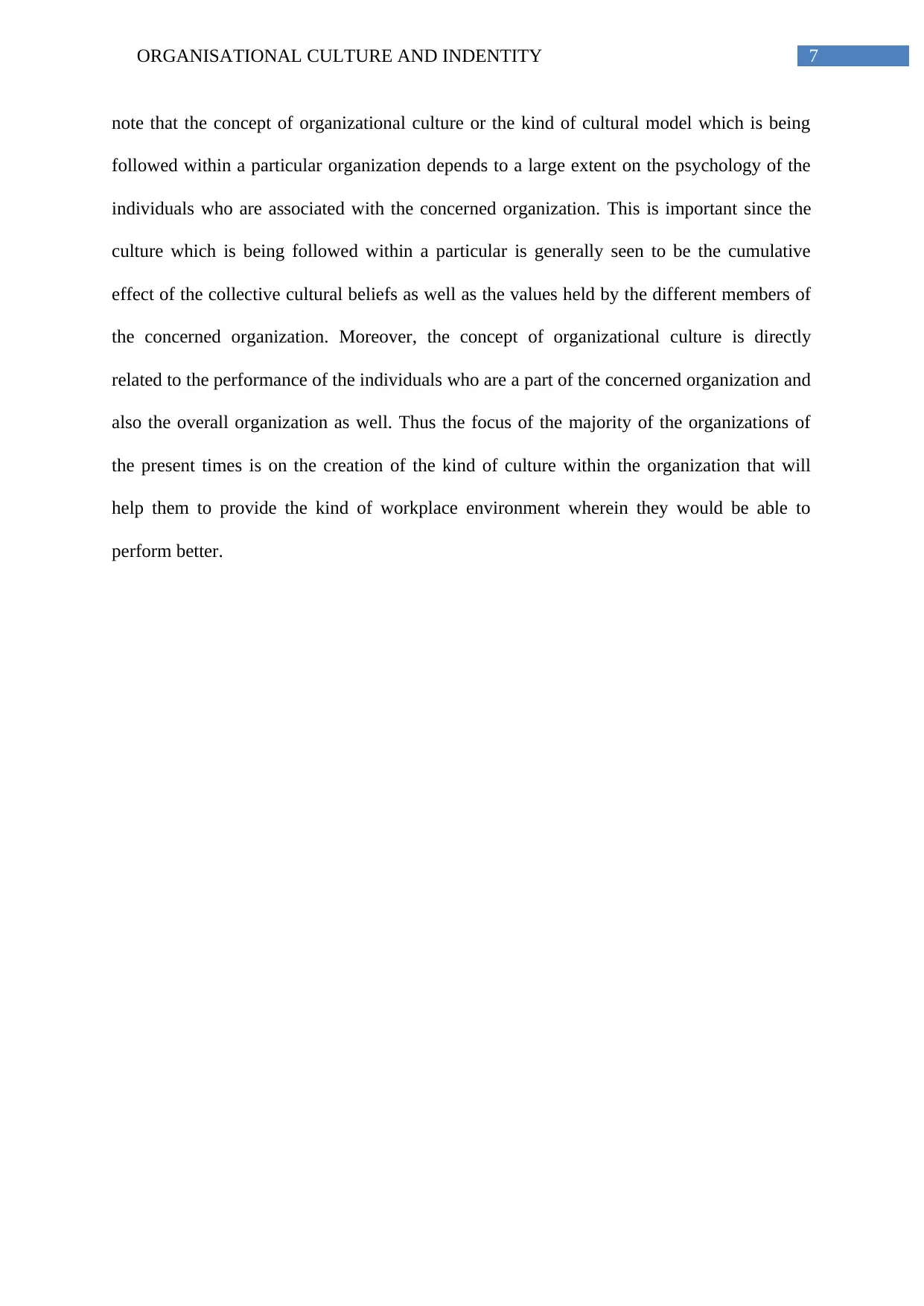
7ORGANISATIONAL CULTURE AND INDENTITY
note that the concept of organizational culture or the kind of cultural model which is being
followed within a particular organization depends to a large extent on the psychology of the
individuals who are associated with the concerned organization. This is important since the
culture which is being followed within a particular is generally seen to be the cumulative
effect of the collective cultural beliefs as well as the values held by the different members of
the concerned organization. Moreover, the concept of organizational culture is directly
related to the performance of the individuals who are a part of the concerned organization and
also the overall organization as well. Thus the focus of the majority of the organizations of
the present times is on the creation of the kind of culture within the organization that will
help them to provide the kind of workplace environment wherein they would be able to
perform better.
note that the concept of organizational culture or the kind of cultural model which is being
followed within a particular organization depends to a large extent on the psychology of the
individuals who are associated with the concerned organization. This is important since the
culture which is being followed within a particular is generally seen to be the cumulative
effect of the collective cultural beliefs as well as the values held by the different members of
the concerned organization. Moreover, the concept of organizational culture is directly
related to the performance of the individuals who are a part of the concerned organization and
also the overall organization as well. Thus the focus of the majority of the organizations of
the present times is on the creation of the kind of culture within the organization that will
help them to provide the kind of workplace environment wherein they would be able to
perform better.
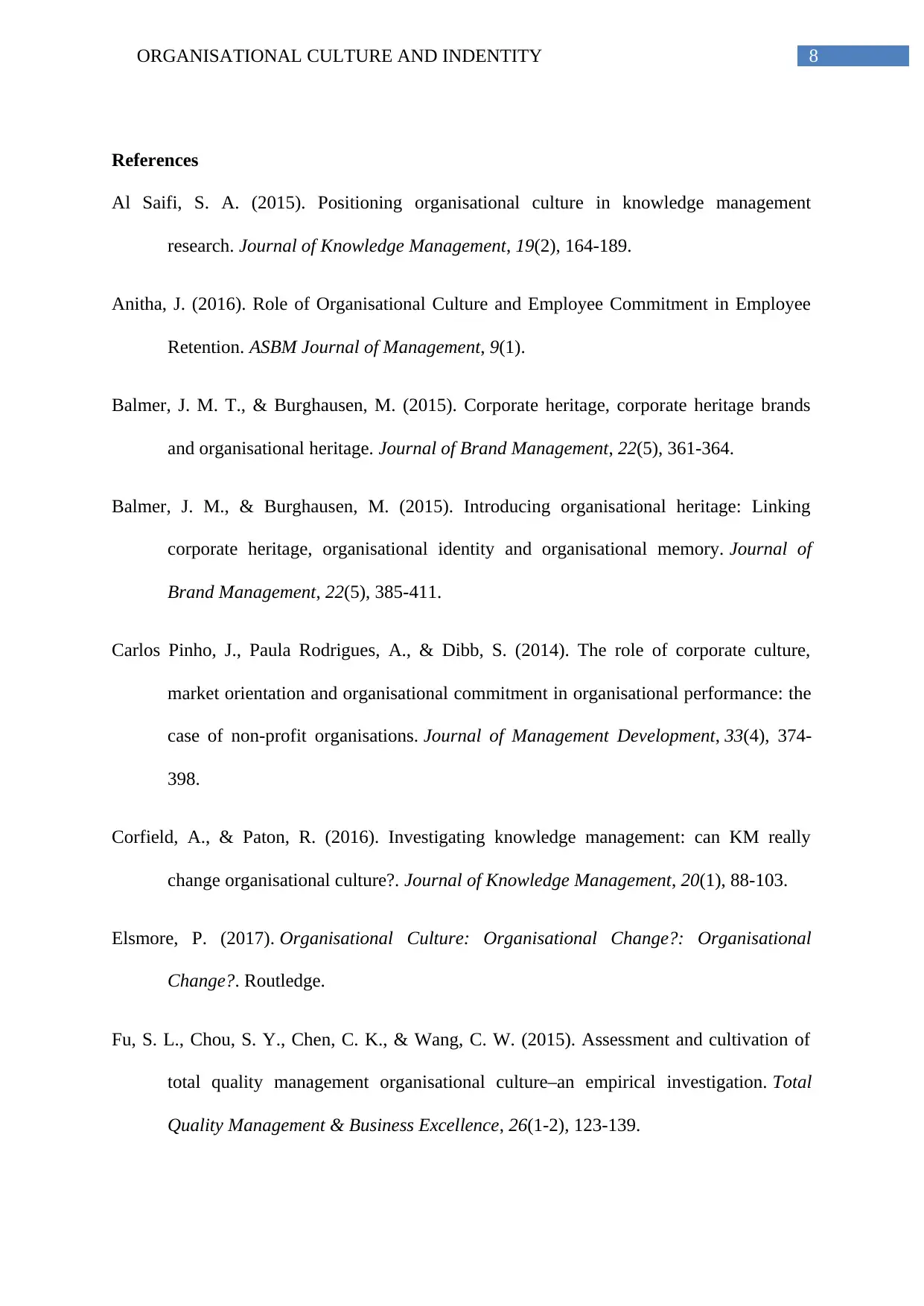
8ORGANISATIONAL CULTURE AND INDENTITY
References
Al Saifi, S. A. (2015). Positioning organisational culture in knowledge management
research. Journal of Knowledge Management, 19(2), 164-189.
Anitha, J. (2016). Role of Organisational Culture and Employee Commitment in Employee
Retention. ASBM Journal of Management, 9(1).
Balmer, J. M. T., & Burghausen, M. (2015). Corporate heritage, corporate heritage brands
and organisational heritage. Journal of Brand Management, 22(5), 361-364.
Balmer, J. M., & Burghausen, M. (2015). Introducing organisational heritage: Linking
corporate heritage, organisational identity and organisational memory. Journal of
Brand Management, 22(5), 385-411.
Carlos Pinho, J., Paula Rodrigues, A., & Dibb, S. (2014). The role of corporate culture,
market orientation and organisational commitment in organisational performance: the
case of non-profit organisations. Journal of Management Development, 33(4), 374-
398.
Corfield, A., & Paton, R. (2016). Investigating knowledge management: can KM really
change organisational culture?. Journal of Knowledge Management, 20(1), 88-103.
Elsmore, P. (2017). Organisational Culture: Organisational Change?: Organisational
Change?. Routledge.
Fu, S. L., Chou, S. Y., Chen, C. K., & Wang, C. W. (2015). Assessment and cultivation of
total quality management organisational culture–an empirical investigation. Total
Quality Management & Business Excellence, 26(1-2), 123-139.
References
Al Saifi, S. A. (2015). Positioning organisational culture in knowledge management
research. Journal of Knowledge Management, 19(2), 164-189.
Anitha, J. (2016). Role of Organisational Culture and Employee Commitment in Employee
Retention. ASBM Journal of Management, 9(1).
Balmer, J. M. T., & Burghausen, M. (2015). Corporate heritage, corporate heritage brands
and organisational heritage. Journal of Brand Management, 22(5), 361-364.
Balmer, J. M., & Burghausen, M. (2015). Introducing organisational heritage: Linking
corporate heritage, organisational identity and organisational memory. Journal of
Brand Management, 22(5), 385-411.
Carlos Pinho, J., Paula Rodrigues, A., & Dibb, S. (2014). The role of corporate culture,
market orientation and organisational commitment in organisational performance: the
case of non-profit organisations. Journal of Management Development, 33(4), 374-
398.
Corfield, A., & Paton, R. (2016). Investigating knowledge management: can KM really
change organisational culture?. Journal of Knowledge Management, 20(1), 88-103.
Elsmore, P. (2017). Organisational Culture: Organisational Change?: Organisational
Change?. Routledge.
Fu, S. L., Chou, S. Y., Chen, C. K., & Wang, C. W. (2015). Assessment and cultivation of
total quality management organisational culture–an empirical investigation. Total
Quality Management & Business Excellence, 26(1-2), 123-139.
⊘ This is a preview!⊘
Do you want full access?
Subscribe today to unlock all pages.

Trusted by 1+ million students worldwide
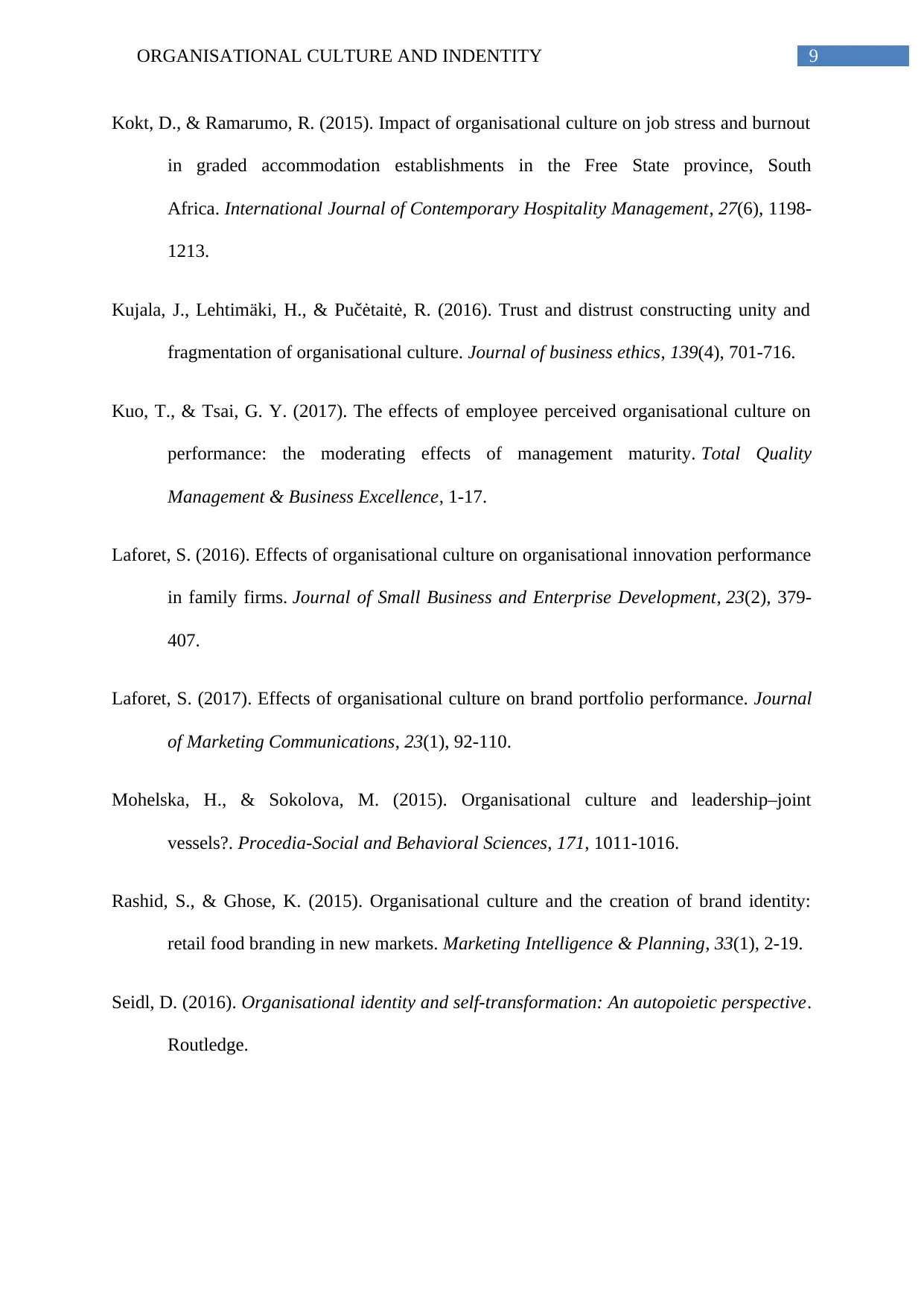
9ORGANISATIONAL CULTURE AND INDENTITY
Kokt, D., & Ramarumo, R. (2015). Impact of organisational culture on job stress and burnout
in graded accommodation establishments in the Free State province, South
Africa. International Journal of Contemporary Hospitality Management, 27(6), 1198-
1213.
Kujala, J., Lehtimäki, H., & Pučėtaitė, R. (2016). Trust and distrust constructing unity and
fragmentation of organisational culture. Journal of business ethics, 139(4), 701-716.
Kuo, T., & Tsai, G. Y. (2017). The effects of employee perceived organisational culture on
performance: the moderating effects of management maturity. Total Quality
Management & Business Excellence, 1-17.
Laforet, S. (2016). Effects of organisational culture on organisational innovation performance
in family firms. Journal of Small Business and Enterprise Development, 23(2), 379-
407.
Laforet, S. (2017). Effects of organisational culture on brand portfolio performance. Journal
of Marketing Communications, 23(1), 92-110.
Mohelska, H., & Sokolova, M. (2015). Organisational culture and leadership–joint
vessels?. Procedia-Social and Behavioral Sciences, 171, 1011-1016.
Rashid, S., & Ghose, K. (2015). Organisational culture and the creation of brand identity:
retail food branding in new markets. Marketing Intelligence & Planning, 33(1), 2-19.
Seidl, D. (2016). Organisational identity and self-transformation: An autopoietic perspective.
Routledge.
Kokt, D., & Ramarumo, R. (2015). Impact of organisational culture on job stress and burnout
in graded accommodation establishments in the Free State province, South
Africa. International Journal of Contemporary Hospitality Management, 27(6), 1198-
1213.
Kujala, J., Lehtimäki, H., & Pučėtaitė, R. (2016). Trust and distrust constructing unity and
fragmentation of organisational culture. Journal of business ethics, 139(4), 701-716.
Kuo, T., & Tsai, G. Y. (2017). The effects of employee perceived organisational culture on
performance: the moderating effects of management maturity. Total Quality
Management & Business Excellence, 1-17.
Laforet, S. (2016). Effects of organisational culture on organisational innovation performance
in family firms. Journal of Small Business and Enterprise Development, 23(2), 379-
407.
Laforet, S. (2017). Effects of organisational culture on brand portfolio performance. Journal
of Marketing Communications, 23(1), 92-110.
Mohelska, H., & Sokolova, M. (2015). Organisational culture and leadership–joint
vessels?. Procedia-Social and Behavioral Sciences, 171, 1011-1016.
Rashid, S., & Ghose, K. (2015). Organisational culture and the creation of brand identity:
retail food branding in new markets. Marketing Intelligence & Planning, 33(1), 2-19.
Seidl, D. (2016). Organisational identity and self-transformation: An autopoietic perspective.
Routledge.
Paraphrase This Document
Need a fresh take? Get an instant paraphrase of this document with our AI Paraphraser
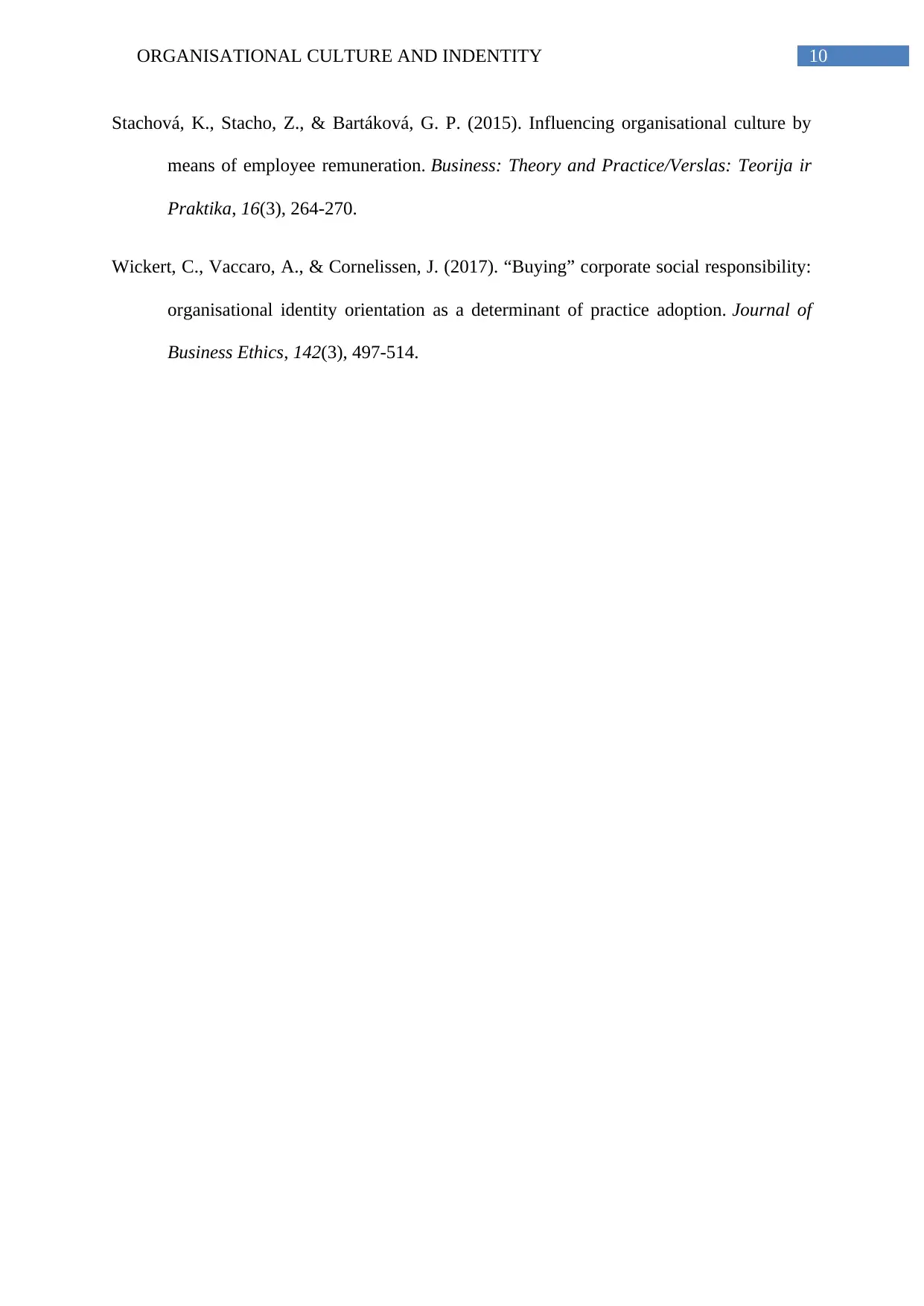
10ORGANISATIONAL CULTURE AND INDENTITY
Stachová, K., Stacho, Z., & Bartáková, G. P. (2015). Influencing organisational culture by
means of employee remuneration. Business: Theory and Practice/Verslas: Teorija ir
Praktika, 16(3), 264-270.
Wickert, C., Vaccaro, A., & Cornelissen, J. (2017). “Buying” corporate social responsibility:
organisational identity orientation as a determinant of practice adoption. Journal of
Business Ethics, 142(3), 497-514.
Stachová, K., Stacho, Z., & Bartáková, G. P. (2015). Influencing organisational culture by
means of employee remuneration. Business: Theory and Practice/Verslas: Teorija ir
Praktika, 16(3), 264-270.
Wickert, C., Vaccaro, A., & Cornelissen, J. (2017). “Buying” corporate social responsibility:
organisational identity orientation as a determinant of practice adoption. Journal of
Business Ethics, 142(3), 497-514.
1 out of 11
Related Documents
Your All-in-One AI-Powered Toolkit for Academic Success.
+13062052269
info@desklib.com
Available 24*7 on WhatsApp / Email
![[object Object]](/_next/static/media/star-bottom.7253800d.svg)
Unlock your academic potential
Copyright © 2020–2025 A2Z Services. All Rights Reserved. Developed and managed by ZUCOL.



